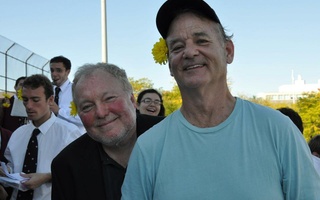I tend to associate Hawkins with a number of other tenor players of the era who played with an explicitly forceful swing feel and a rather heavy, expansive tone with a generous amount of vibrato in their sounds: Don Byas (also an influence on Parker), Ben Webster, and later Paul Gonsalves come to mind. Young, who had a buoyant sense of time that was just as propulsive as Hawkins’s but less explicitly so—achieved through the rhythmic motifs and syncopations within his lines rather than in the articulation of the notes themselves—is generically described as having a light, airy sound with almost no vibrato, i.e., a “cool” counterpart to Hawkins’s “hot” sound.
Dexter Gordon
While Charlie Parker was indisputably the first proponent of bebop on the alto saxophone, Gordon is generally considered the first leading player of bebop on the tenor saxophone. He was also influenced heavily by Lester Young’s sense of melody and time, and he used far less vibrato than either Young or Hawkins; his sound is also harder, more square than round compared to his tenor antecedents, which would be a hallmark of his legacy in the tradition of the tenor saxophone sound.
Sonny Rollins
Although John Coltrane was born before either Sonny Rollins or Stan Getz, his emergence as an innovator and leading saxophonist of his generation came relatively late behind Rollins and Getz. In fact, although they were all peers, Rollins and Getz were each initially major figures with whom Coltrane had to contend when developing his own approach and his own sound. Rollins grew up in Harlem in the ’30s and ’40s among both peers and older figures, including Hawkins, and by 21 was recording the next generation of bebop with Miles Davis. His indebtedness to Charlie Parker’s rhythmic and harmonic innovations is undeniable, and he’s generally considered the tenor saxophonist whose approach to rhythm was most similar to Parker’s own.
Stan Getz
Stan Getz came up through Woody Herman’s big band in the late ’40s. He had his big break after his solo on the ballad “Early Autumn,” which made him a household name. A musical descendant of Lester Young with regards to tone and melodic phrasing, Getz and a number of other white saxophonists of the era (Zoot Sims, Al Cohn, Jimmy Giuffre, Paul Desmond) are often lumped together, but each diverged towards separate paths as they matured. Coltrane is famously quoted as saying of Getz, “We’d all sound like that if we could.”
John Coltrane
There are early recordings of Coltrane playing alto saxophone during his years in the Navy. His playing is a poor imitation of Charlie Parker’s, and there is no sense that this musician would later become, arguably, the most influential jazz musician of the past 50 years. When he replaced Sonny Rollins in Miles Davis’s band in the ’50s, critics almost unanimously registered their dissatisfaction with this largely unknown saxophonist, who they criticized for unsophisticated harmonic choices and general inconsistency of playing. But between ’57, when he recorded “Blue Train,” and ’59, when he recorded “Giant Steps,” Coltrane’s harmonic innovations thrust him to the forefront of saxophonists, where he maintained a monolithic presence until he succumbed to liver cancer only a decade later.
Joe Henderson & Wayne Shorter
Read more in Arts
Smart Girls at the PartyRecommended Articles
-
Colleges Alter Application ProcessesAs high school seniors wade through the college admissions process, some schools are updating their applications in a stated effort ...
-
HUDS Satisfaction DeclinesStudent satisfaction with all aspects of the dining services dropped this year, according to a survey released yesterday.
-
 Bill Murray Conducts the Harvard Band (In Pink Shorts!)
Bill Murray Conducts the Harvard Band (In Pink Shorts!) -
 Emily Tay '09 Featured in Documentary
Emily Tay '09 Featured in Documentary -
Crimson Eyes Europe BallCo-captain Brogan Berry currently has her eyes set on Princeton, Yale, and the rest of the Ivy League. But a year from now, she could be preparing for Bourges, Rivas Ecopolis, or Taranto.
-
Monson Explores the Intricacies of Coltrane“The relationship of the words to the music was a bit of a secret to be discovered,” said Monson. “Not even the musicians in the band knew that he was using a text, which suggests that he had it memorized.”













